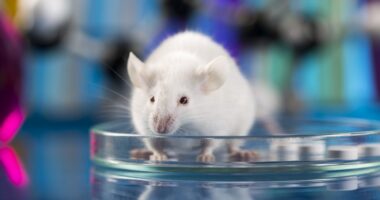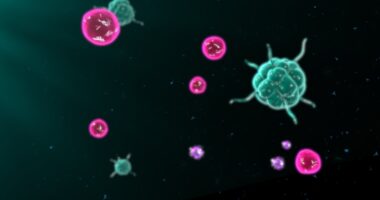Stem Cells Grown in 3D Conditions May Lose Anti-scarring Properties

Mesenchymal stem cells (MSCs) grown in three-dimension (3D) conditions produce tiny extracellular vesicles (EVs) that do not retain the anti-scarring and anti-inflammatory properties seen when they are derived from MSCs grown in two dimensions (2D), a study shows.
These findings, obtained from treating a mouse model of pulmonary fibrosis (PF) with EVs derived from either 2D or 3D MSCs, highlight the importance of the right microenvironmental cues for EV production and therapeutic potential.
Given that interest in MSC- and EV-based therapies for tissue repair and regeneration — including in PF — has increased, these results show a potential limitation for the 3D-based manufacture scaling needed for therapeutic use, the researchers said.
“All cell types release natural nanoparticles [such as EVs] which have biological activity,” Rebecca Lim, PhD, the study’s senior author and an associate professor at Hudson Institute of Medical Research, said in a university press release.
“This study uncovers critical information that will help improve scalable manufacturing of these nanoparticles and may be applied to other cell types beyond MSCs,” Lim added.
Further research is needed to determine the best microenvironmental conditions for MSC growth to produce EVs with optimal therapeutic potential.
The study, “Effect of 2D and 3D Culture Microenvironments on Mesenchymal Stem Cell-Derived Extracellular Vesicles Potencies,” was published in Frontiers in Cell and Developmental Biology.
PF is marked by scarring (fibrosis) in the lungs, the result of fibroblast activation, or maturation, into myofibroblasts — the main cellular drivers of lung fibrosis that produce excessive amounts of extracellular matrix (ECM) molecules.
ECM molecules, such as collagen, surround and support cells, but when too much is produced it can cause tissue scarring.
MSCs — stem cells that can generate a variety of other cell types — have gained in interest for treating PF due to their anti-inflammatory and anti-fibrotic properties and were shown to ease idiopathic pulmonary fibrosis (IPF) in several animal models. IPF is a form of PF with no clear cause.
Their beneficial effects are believed to be mediated in part by the release of tiny particles, called EVs, that carry signaling molecules to other cells. EVs are essential for a wide range of cell functions and have been linked to developing IPF.
EVs’ content “typically reflect their parental cells, cell culture conditions and microenvironmental stimuli that triggered their release,” and the therapeutic potential of MSC-derived EVs has been shown to be similar or even superior to that of MSCs themselves, the researchers wrote.
As such, cell-free therapy using EVs may present as an improved approach relative to MSC-based therapy, which is associated with “high cost of goods, safety and logistical challenges,” the researchers said.
MSCs are typically grown on nonphysiological 2D plastic lab dishes, but growing them in 3D spheres not only has been associated with increased therapeutic effectiveness, but also would allow for producing large cell numbers needed for therapeutic applications.
Lim’s team, along with colleagues at other Australian institutions, evaluated the impact of MSC 3D growth on EV production and their immunomodulatory, anti-inflammatory, and anti-fibrotic properties. The latter was assessed both in lab dish-based assays and in a standard PF mouse model.
Results showed that EV production, size, and surface markers were comparable between MSCs grown in 2D or 3D.
However, EVs from 3D-grown MSCs exhibited significantly reduced anti-inflammatory and immunomodulating effects, but comparable anti-fibrotic properties, in lab dish assays relative to those from cells grown in 2D.
In the IPF mouse model, treatment with 3D MSC-derived EVs led to increased collagen deposition, myofibroblast maturation, and immune cell infiltration in the animals’ lungs, as well as worse lung function, relative to EVs derived from 2D MSCs.
Mice treated with 2D MSC-derived EVs generally showed better outcomes than those given the IPF approved therapy Esbriet (pirfenidone) in parallel experiments.
EVs from 3D MSCs were enriched in proteins involved in pro-inflammatory and pro-fibrotic processes, while those from 2D MSCs contained more proteins involved in anti-fibrotic/ECM-disassembling processes, analyses showed.
These findings highlight that “the microenvironmental conditions will affect EV content and function,” and that 3D MSC-derived EVs, at least in the evaluated conditions, “are not a viable alternative to 2D monolayer MSC as 3D EVs did not retain MSC anti-fibrotic and anti-immunomodulatory properties,” the researchers wrote.
“The upshot of this study is that manufacturing is an important aspect of clinical applications, and if we cannot manufacture at scale, then there is no translation to the marketplace and the broader public beyond small clinical trials,” Lim said.
The research team said further studies will explore “several avenues in dynamic 3D [MSC growth] conditions and modulating [MSC sphere] sizes as the next steps towards bringing scalable MSC-EVs manufacturing for clinical applications.”








